A 10-home subdivision for low-income families is headed for the Father Blanchet Park neighborhood — the largest subdivision built by Evergreen Habitat for Humanity, the nonprofit organization’s president, Josh Townsley, announced Wednesday at a fundraising breakfast.
The organization bought a 1.53-acre parcel on the south side of Southeast Middle Way at 77th Court, just north of state Highway 14. The project, called the Middle Way Subdivision, includes three duplexes and four detached single-family homes that will each be 1,100 to 1,300 square feet. Construction manager Kris Cowan said the project is expected to be complete sometime around December 2017. Evergreen Habitat for Humanity previously built a nine-home development off Padden Parkway, but Middle Way will be the largest yet, Cowan said.
“We believe everyone deserves a decent place to live. That’s all it comes down to,” Townsley said.
Since 1991, Evergreen Habitat for Humanity has helped lower-income families build homes in Clark County. Homes are sold at no profit with a zero percent interest rate mortgage after the families contribute hundreds of hours of sweat equity.
Subdivisions save time and money because everyone is working and using tools on the same construction site, he said. Typically, multiple homes are built by Habitat at any given time, which usually means staff, volunteers and resources are spread across Clark County.
A cul-de-sac will be constructed for the subdivision, along with utilities, sidewalks, street trees and streetlights.
The announcement comes during what Townsley described as a housing crisis. Rents steadily have gone up over the past several years and recently skyrocketed. According to Apartment List, an apartment-hunting resource, from August 2014 to August 2015, rent for one-bedroom units went up 24.4 percent, averaging $1,000. To follow the rule of spending 30 percent of income on rent, renters would have to make about $40,000 annually.
That makes things difficult for single parents earning minimum wage and supporting a family, Townsley said. Even if a family has enough money, finding a rental can be difficult. The vacancy rate is around 2 percent.
Housing children
School resource centers often see firsthand how housing instability affects families. Carla Feltz was the keynote speaker at Wednesday’s breakfast at the Hilton Vancouver Washington. She’s the family community resource and engagement coordinator at Vancouver’s Washington Elementary School, which has some of the highest poverty rates in the county.
“Poverty and housing instability are synonymous,” Feltz said. “Children were the first to be negatively affected by the recession and the last to recover.”
She works with families who are living in cramped apartments, out of cars, with friends, at shelters and on the streets — moving from one temporary situation to the next. Vancouver Public Schools has 830 homeless students, including 300 who haven’t shown up for school, Feltz said.
“Will they be back? Where are they now?” Feltz said.
Children whose families struggle with housing instability also struggle with school attendance.
Feltz remembered a fifth-grade boy who held onto his backpack like his life depended on it. He took it everywhere with him, whether it was recess or gym class. Teachers weren’t sure what was driving the behavior until one of the boy’s friends expressed concern, saying that he was washing himself in the sink. The boy turned out to be homeless and kept his most valued possessions in his backpack. He was tired, hungry, stressed out and often late or absent from school.
“School was not his priority — survival was,” Feltz said. His family moved from place to place, and the boy was focused on looking after his younger siblings.
Children can get basic needs met at school resource centers, which are stocked with food, clothing and school supplies. Feltz has lost count of the times students have asked for clean socks and underwear.
Safe and affordable housing, however, is not something they can hand out at school. Being homeless negatively affects children’s learning, emotional regulation, and cognitive and social skills, Feltz said. As children reach middle school and high school, the academic stakes are higher, making it more difficult to recover from missed school and lack of stability. Chronically homeless children often turn into chronically homeless adults.
But, Feltz said, early intervention can change that trajectory. School resource centers and Evergreen Habitat for Humanity are partners in the effort to reduce homelessness and set up children for success.




